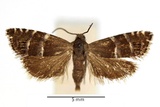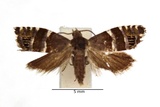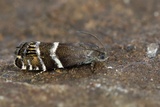Cydia cosmophorana (Treitschke, 1835) Species
Last modified: Dec. 13, 2023, 11:43 a.m.
A very rare and local species in Belgium, with most observations in the northeast part of the country.
Details
- Classification
- Family: Tortricidae > Subfamily: Olethreutinae > Tribus: Grapholitini > Genus: Cydia > Species: Cydia cosmophorana
- Vernacular names
- Bandspiegelmot (NL), Pine Resin Moth, Scarce Pine Piercer (EN), Kiefernbeulenwickler (DE)
- First mention in Belgium
- De Fré Ch. 1858. Catalogue des Microlépidoptères de la Belgique. — Annales de la Société entomologique belge 2: 45–162. On page 89 (as Ephippiphora cosmophorana). view page
- Status
-
Native
Distribution
Imago
Wingspan 8–14 mm. Resembles Cydia conicolana but with distinct, white transverse bands on the forewing.
Brownish grey forewings with the scales tipped with deep golden yellow resulting in a peppered effect which is weak or absent at the base and become stronger towards the termen, especially in the ocellus which has strong black longitudinal stripes.
There are five strong white strigulae on the costa. The first subtends a silver and white fascia reaches to the dorsum which is angled at 110 degrees mid-wing. The second subtends a silver and white fascia, skirting the ocellus to reach the tornus. The fourth spot fascia is broken before skirting the ocellus and the fifth is weak and skirts the apex with a silvery white mark on the termen.
Caterpillar
The caterpillar is almost white yellowish with a light brown head, prothoracic plate yellowish brown and a tiny anal plate.
Bionomics
The larva lives in resin-exuding bark wounds and in galls and resinous nodules on the bark. Hibernates as a larva.
The adults are active during hot weather around midday and afternoon. They come irregularly to light.
Flight periods
The adults fly in two generations a year from late April towards early September. Most observations during May and July.
Observed on
- Host plant (genera):
- Pinus
The larva feeds on Pinus sylvestris, Pinus mugo and Pinus nigra. Also reported on Picea abies but whether this is correct remains unclear. They also have been found in old galls of the tortrix Retinia resinella and of pyralid Dioryctria abietella.
Habitat
It inhabits coniferous plantations and woods.



